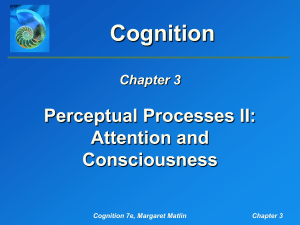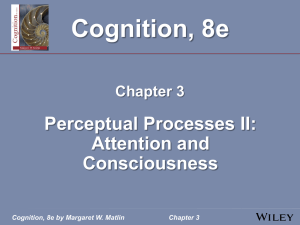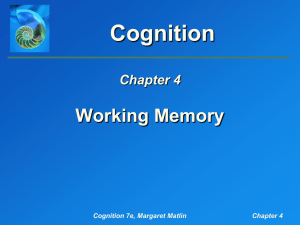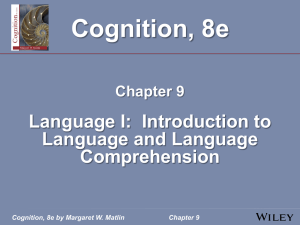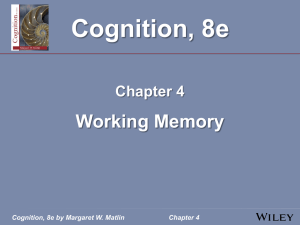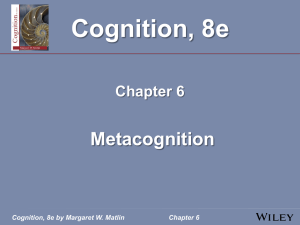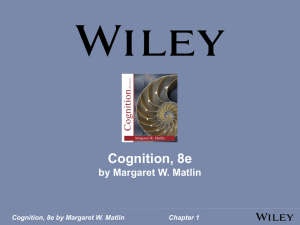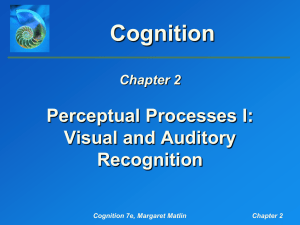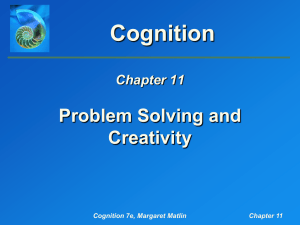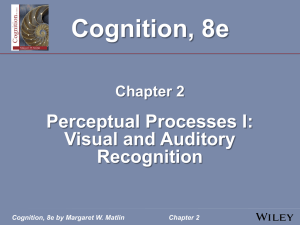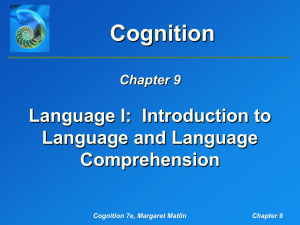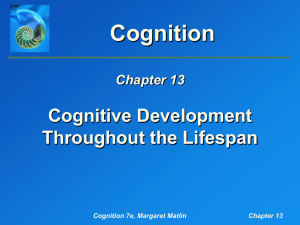Matlin 8e ch12 edited
advertisement
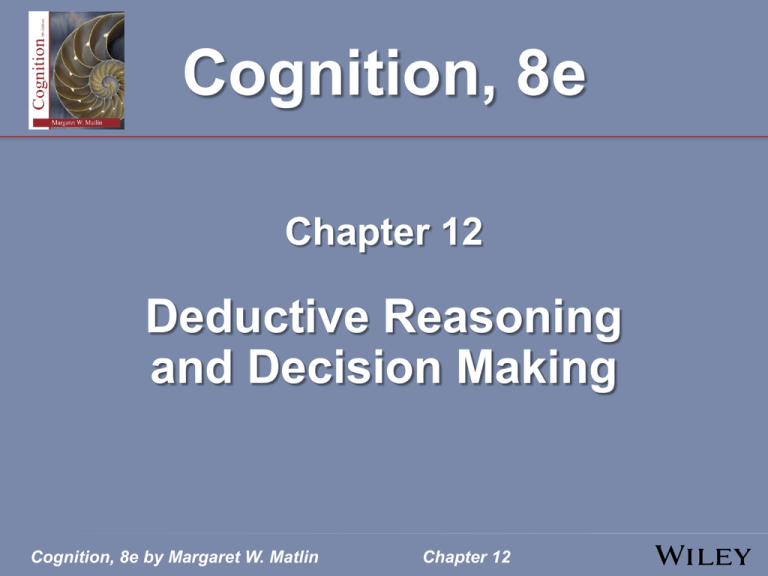
Cognition, 8e Chapter 12 Deductive Reasoning and Decision Making Cognition, 8e by Margaret W. Matlin Chapter 12 Chapter Introduction dual-process theory Type 1 processing—fast and automatic Type 2 processing—slow and controlled Applies to both deductive reasoning and decision making. Cognition, 8e by Margaret W. Matlin Chapter 12 Deductive Reasoning The Confirmation Bias Are human beings rational? The Standard Wason Selection Task Demonstration 12.2: The Confirmation Bias— Wason's Selection Task Cognition, 8e by Margaret W. Matlin Chapter 12 Deductive Reasoning The Confirmation Bias The Standard Wason Selection Task confirmation bias • People tend to try to confirm or support a hypothesis rather than try to disprove it. • In other words, people are eager to affirm the antecedent, but reluctant to deny the consequent by searching for counterexamples. Cognition, 8e by Margaret W. Matlin Chapter 12 Deductive Reasoning The Confirmation Bias Concrete Versions of the Wason Selection Task replace numbers and letters with concrete situations from everyday life People perform much better when the task is concrete, familiar, and realistic. Griggs and Cox (1982)—drinking age example Performance improved when task implies a social contract. Cognition, 8e by Margaret W. Matlin Chapter 12 Deductive Reasoning The Confirmation Bias Applications in Medicine People seek confirming evidence when selfdiagnosing disorders (e.g., insomnia). Both medical students and psychiatrists tend to select information consistent with their original diagnosis rather than investigate information that might be consistent with another diagnosis. Cognition, 8e by Margaret W. Matlin Chapter 12 Decision Making Kahneman and Tversky • proposed that a small number of heuristics guide human decision making • The same strategies that normally guide us toward the correct decision may sometimes lead us astray. Cognition, 8e by Margaret W. Matlin Chapter 12 Decision Making The Representativeness Heuristic representativeness heuristic • People judge that a sample is likely if it is similar to the population from which the sample was selected. • People believe that random-looking outcomes are more likely than orderly outcomes. • This heuristic is so persuasive that people often ignore important statistical information that they should consider. Cognition, 8e by Margaret W. Matlin Chapter 12 Decision Making The Representativeness Heuristic Sample Size and Representativeness hospital babies example A large sample is statistically more likely than a small sample to reflect the true proportions in a population. small-sample fallacy—assume a small sample will be representative of the population from which it was selected Cognition, 8e by Margaret W. Matlin Chapter 12 Decision Making The Representativeness Heuristic Base Rate and Representativeness Demonstration 12.3: Base Rates and Representativeness—Tom W base rate—how often an item occurs in the population base-rate fallacy—emphasize representativeness and underemphasize important information about base rates Cognition, 8e by Margaret W. Matlin Chapter 12 Decision Making The Representativeness Heuristic The Conjunction Fallacy and Representativeness Demonstration 12.4: Tversky and Kahneman • "Linda is a bank teller and a feminist." • students with different levels of statistical sophistication • rank statements in terms of probability Cognition, 8e by Margaret W. Matlin Chapter 12 Decision Making The Representativeness Heuristic The Conjunction Fallacy and Representativeness conjunction rule—The probability of the conjunction of two events cannot be larger than the probability of either of its constituent events. conjunction fallacy—when people judge the probability of the conjunction of two events to be greater than the probability of a constituent event Cognition, 8e by Margaret W. Matlin Chapter 12 Decision Making The Availability Heuristic availability heuristic—estimate frequency or probability in terms of how easy it is to think of relevant examples only accurate when availability is correlated with true, objective frequency can be distorted by recency and familiarity Cognition, 8e by Margaret W. Matlin Chapter 12 Decision Making The Availability Heuristic Recency and Availability • Memory is better for more recent items. • Recent items are more available. • People judge recent items to be more likely than they really are. Cognition, 8e by Margaret W. Matlin Chapter 12 Decision Making The Availability Heuristic Recency and Availability MacLeod and Campbell (1992) • When people were encouraged to recall pleasant events from their past, they later judge pleasant events to be more likely in their future. • When people were encouraged to recall unpleasant events, they later judged unpleasant events to be more likely. • implications for psychotherapy Cognition, 8e by Margaret W. Matlin Chapter 12 Decision Making The Availability Heuristic Familiarity and Availability Brown and colleagues population estimates for various countries points of view shown by the media People need to use critical thinking and shift to Type 2 processing. Cognition, 8e by Margaret W. Matlin Chapter 12 Decision Making The Availability Heuristic The Recognition Heuristic When comparing the relative frequency of two categories, if people recognize one category and not the other, they conclude that the recognized category has the higher frequency. This strategy generally leads to an accurate decision. Cognition, 8e by Margaret W. Matlin Chapter 12 Decision Making The Anchoring and Adjustment Heuristic Demonstration 12.5 When making an estimate, people begin with a first approximation (anchor) and then make adjustments to that number on the basis of additional information. People rely too heavily on the anchor, and their adjustments are too small; over-influence of current hypotheses or beliefs, top-down processing Cognition, 8e by Margaret W. Matlin Chapter 12 Decision Making The Anchoring and Adjustment Heuristic Research on the Anchoring and Adjustment Heuristic Demonstration 12.5: Multiplication If the first number was large, the estimates were higher than if the first number was small. single-digit numbers anchored the estimates far too low Cognition, 8e by Margaret W. Matlin Chapter 12 Decision Making The Anchoring and Adjustment Heuristic Research on the Anchoring and Adjustment Heuristic • operates even when anchor is obviously arbitrary or impossibly extreme • operates for both novices and experts • anchor may restrict the search for relevant information in memory • applications in everyday life: courtroom sentences Cognition, 8e by Margaret W. Matlin Chapter 12 Decision Making The Framing Effect framing effect—the outcome of a decision can be influenced by: 1) the background context of the choice 2) the way in which a question is worded Cognition, 8e by Margaret W. Matlin Chapter 12 Decision Making The Framing Effect The Wording of a Question and the Framing Effect People are distracted by surface structure of the questions. The exact wording of a question can have a major effect on the answers. Cognition, 8e by Margaret W. Matlin Chapter 12 Decision Making The Framing Effect The Wording of a Question and the Framing Effect Tversky and Kahneman (1981)—lives saved/lives lost study (Demonstration 12.8) • "lives saved" question led to more "risk averse" choices • "lives lost" question led to more "risk taking" choices Cognition, 8e by Margaret W. Matlin Chapter 12 Decision Making The Framing Effect The Wording of a Question and the Framing Effect prospect theory 1. When dealing with possible gains (for example, lives saved), people tend to avoid risks. 2. When dealing with possible losses (for example, lives lost), people tend to seek risks. Cognition, 8e by Margaret W. Matlin Chapter 12 Decision Making In Depth: Overconfidence About Decisions General Studies on Overconfidence • occurs in a variety of situations • own decisions vs. statistically observable measurements • variety of personal skills • individual differences • cross-cultural differences Cognition, 8e by Margaret W. Matlin Chapter 12 Decision Making In Depth: Overconfidence About Decisions Overconfidence in Political Decision Making sexual scandals international conflict failure to think systematically about the risks involved Each side tends to overestimate its own chances of success. Cognition, 8e by Margaret W. Matlin Chapter 12 Decision Making In Depth: Overconfidence About Decisions Overconfidence in Political Decision Making Politicians are often overconfident that their data are accurate. crystal-ball technique—imagine a completely accurate crystal ball indicates that your hypothesis is incorrect Cognition, 8e by Margaret W. Matlin Chapter 12 Decision Making In Depth: Overconfidence About Decisions Overconfidence About Completing Projects on Time planning fallacy • underestimate the amount of time (or money) required to complete a project • estimate the task will be relatively easy to complete Cognition, 8e by Margaret W. Matlin Chapter 12 Decision Making In Depth: Overconfidence About Decisions Overconfidence About Completing Projects on Time Possible Explanations • optimistic scenario • failure to consider potential problems • memory for similar tasks • over-estimate future free time Cognition, 8e by Margaret W. Matlin Chapter 12 Decision Making In Depth: Overconfidence About Decisions Reasons for Overconfidence 1. People are often unaware that their knowledge is based on very tenuous and uncertain assumptions and on information from unreliable or inappropriate sources. 2. Examples that confirm our hypotheses are readily available, whereas we resist searching for counterexamples. Cognition, 8e by Margaret W. Matlin Chapter 12 Decision Making In Depth: Overconfidence About Decisions Reasons for Overconfidence 3. People have difficulty recalling the other possible hypotheses, and decision making depends on memory. If you cannot recall the competing hypotheses, you will be overly confident about the hypothesis you have endorsed. Cognition, 8e by Margaret W. Matlin Chapter 12 Decision Making In Depth: Overconfidence About Decisions Reasons for Overconfidence 4. Even if people manage to recall the other possible hypotheses, they do not treat them seriously. 5. Researchers do not educate the public about the overconfidence problem. As a result, we typically do not pause and ask ourselves, ‘‘Am I relying only on Type 1 thinking? I need to switch over to Type 2 thinking!’’ Cognition, 8e by Margaret W. Matlin Chapter 12 Decision Making In Depth: Overconfidence About Decisions my-side bias—overconfidence that one's own view is correct in a confrontational situation; often results in conflict; cannot even consider the possibility that their opponent's position may be at least partially correct Cognition, 8e by Margaret W. Matlin Chapter 12 Decision Making The Hindsight Bias hindsight—judgments about events that already happened in the past hindsight bias—judging an event as inevitable, after the event has already happened; overconfidence that we could have predicted the outcome in advance Cognition, 8e by Margaret W. Matlin Chapter 12 Decision Making The Hindsight Bias Research About the Hindsight Bias Carli (1999)—judgments about people; Barbara/Jack study happy vs. tragic ending Both groups are confident that they could have predicted the ending. Memory errors are consistent with the outcome. Cognition, 8e by Margaret W. Matlin Chapter 12 Decision Making The Hindsight Bias Research About the Hindsight Bias (continued) political events business decisions Explanations for the Hindsight Bias anchoring and adjustment misremembering past events Cognition, 8e by Margaret W. Matlin Chapter 12 Decision Making Current Status of Heuristics and Decision Making Kahneman's heuristic approach may be too pessimistic Harris and colleagues—People make fairly realistic judgments about future events. Cognition, 8e by Margaret W. Matlin Chapter 12 Decision Making Current Status of Heuristics and Decision Making Girgerenzer and colleagues • People are not perfectly rational decision makers, however people can do relatively well when they are given a fair chance. • ecological rationality—People create a wide variety of heuristics to help them make useful, adaptive decisions in the real world. Cognition, 8e by Margaret W. Matlin Chapter 12 Decision Making Current Status of Heuristics and Decision Making Girgerenzer and colleagues • default heuristic—If there is a default option, then people will choose it. • People bring world knowledge into the research laboratory. Cognition, 8e by Margaret W. Matlin Chapter 12 Decision Making Current Status of Heuristics and Decision Making Both Kahneman's and Gigerenzer's approaches suggest that decision-making heuristics generally serve us well in the real world. We can become more effective decision makers by realizing the limitations of these important strategies. Cognition, 8e by Margaret W. Matlin Chapter 12 Decision Making Individual Differences: DecisionMaking Style and Psychological WellBeing Maximizers—tend to examine as many options as possible (maximizing decision-making style); may lead to "choice overload" Satisficers—tend to settle for something that is satisfactory (satisficing decision-making style) Cognition, 8e by Margaret W. Matlin Chapter 12 Decision Making Individual Differences: DecisionMaking Style and Psychological WellBeing Schwartz and coauthors (2002)— Demonstration 12.9 • maximizer/satisficer scale and several other measures • students, healthcare professionals, people waiting in a train station Cognition, 8e by Margaret W. Matlin Chapter 12 Decision Making Individual Differences: DecisionMaking Style and Psychological WellBeing Schwartz and coauthors (2002) (continued) • Maximizers tended to experience more regret following a choice than satisficers. • Maximizers tended to experience more depressive symptoms than satisficers. • More choices don't necessarily make a person happier. Cognition, 8e by Margaret W. Matlin Chapter 12
